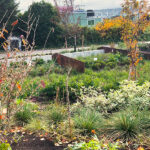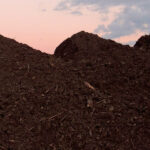A microbial, community ecology approach to design compost amendments creates more reliable and resilient methods to suppress globally distributed soilborne pathogens.
Deborah A. Neher
BioCycle November/December 2019

Magnification of pathogenic Rhizoctonia solani isolated from soil on an organic vegetable farm in Vermont. Photo by Charlotte Brodie
I am a soil ecologist and my goal is to discover the operative mechanisms of how compost microbes suppress plant pathogens and disease. My approach integrates soil biology, organic wastes, and product development to suppress plant disease and increase agricultural productivity through natural mechanisms. Organic wastes are a global issue and, with local sourcing, can close the nutrient loop providing equitable access that is scale-neutral. Innovation focuses on the process of converting organic waste into designer composts to manage global soil pathogens that limit yield of major food crops.
For the past five years, I’ve been working with Rhizoctonia solani, adapting my prior experience with Pythium and Phytophthora. Rhizoctonia solani is an aggressive pathogen that is distributed globally, causing disease on a wide range of plant hosts including Solanaceae, Fabaceae, Asteraceae, and Brassicaceae, resulting in serious economic losses. For example, in the U.S., more than 24 percent of acres planted with sugar beet suffer economic loss from R. solani alone. The pathogen reduces lettuce yield up to 50 percent in the San Joaquin Valley and desert production areas, and 30 to 50 percent in Vermont. Globally, organic and smallholder farmers face chronic disease challenges that regularly compromise their yields.
My biological/ecological approach to managing soil for food production has tremendous potential impact on the security of global food systems. Using a microbial, community ecology approach to design compost amendments creates more reliable and resilient methods to suppress globally distributed soilborne pathogens that currently threaten food security. It is at this intersection where high quality research translates into environmentally and financially sound agricultural practices and products.
Early Research
Most of what we know about disease suppression from composts is from controlled environments rather than field conditions (Hoitink and Boehm 1999), and the literature is full of inconsistent results from field experiments. Single strain biocontrol products work sporadically because soil ecosystems naturally resist invasion. Harry Hoitink, an innovator of the 1980s, demonstrated that composts prepared from lignocellulosic substrates, such as tree barks, become colonized by Trichoderma spp., an effective biocontrol of Rhizoctonia.

Time series photos highlight biological activity in a green pea sized (5 mm) clump of mature compost straight from the pile (1). A drop of water was added and a network of fungal hyphae glisten in the light (2). Looking at various depths of field, clumps of spores or eggs are visible at junctures of the hyphae (3). At the margin, bacterial-feeding nematodes are swimming out from the compost (4). The small perfectly round spheres among the nematodes are protozoa, and the smallest particles are either mineral particles, or bacteria in some cases. Photos by John Miller
Others have tried to inoculate curing compost with Trichoderma spp. without success. Culture-independent methods detect greater abundance of related species, but not specifically Trichoderma, in hardwood bark compost, suggesting multiple species play similar ecological roles (Neher et al., 2013). My ultimate goal is to develop function-based compost products that control disease and promote plant growth. Innovation is associated with the recipe and process more so than the specific species of microbes, based on the tenet that natural soil communities have inherent functional redundancy.
My work integrates deeply with farmers and organizations seeking solutions to these challenges. For example, during a late blight on tomato outbreak in 2009, farmers were hauling diseased plants to the landfill, which can result in economic and nutrient losses for farmers. I started a demonstration project with Highfields Center of Composting in Vermont to examine whether properly composted material is pathogen free and a means to keep nutrients and organic matter on the farm. The resulting compost was surface applied to Brassica fields at two farms and we monitored all disease(s) that occurred naturally. There was less disease in plots with compost than without, and least in those with hardwood carbon (Neher et al., 2014). In a collaboration with U.S. Department of Agriculture (USDA) Agricultural Research Service scientists, I discovered that poultry based compost products are conducive to R. solani and E. coli rather than suppressive as in dairy manure composts. This is not simply explained by high ammonium levels but also microbial communities (Neher et al., 2017, 2019).
Compost’s Biological Dynamics
From my vantage point, I define composting as a controlled aerobic process that degrades organic waste to stable material, with the resident microbial community mediating the biodegradation and conversion processes. Commercial composting guidelines require a high-temperature phase designed to facilitate the removal of human and plant pathogens. These requirements stop short of guidelines for compost curing (cooling) in the post-thermophilic phase. The curing phase offers a substrate and climate conducive for microbial recolonization, accomplished by either inoculating post-thermophilic compost or creating a palatable substrate that offers a competitive advantage for colonization by bacteria and fungi capable of suppressing soilborne pathogens.
Generally, we have a poor understanding of the biological dynamics that occur during the composting process and there are no current regulations or guidelines that define desirable microbiological properties of compost. Most studies have utilized culture-based methods that are known to only capture a small portion of the microbial diversity found in environmental samples. My pioneering study that used high-throughput sequencing techniques showed that the compost recipe, choice of post-thermophilic process, and duration of curing (maturation) of composts influences the assembly of bacterial and fungal communities (Neher et al., 2013).
Economic considerations have driven commercial composters to expedite the composting process. As a result, the focus has been on the effectiveness of the thermophilic phase. However, if compost is allowed to mature and cure, it has functions beyond fertility and carbon sequestration. The composition of carbon compounds in the final product differentially selects a consortium of microorganisms that colonize the compost during the cooling phase of the process and are antagonistic to pathogens (Hadar and Papadopoulou, 2012). The exact composition of a consortium is locally adapted similar to land races. These microbes have evolved defenses (against other microbes) that can be harnessed to target and suppress plant pathogens. However, there is a paucity of field experiments to support this claim.
With a better understanding of the microbiology of composting, we can learn the pivotal points where it can be managed to enhance disease suppressiveness either by regulating the microbe-microbe interactions or microbe-plant interactions in soil. This knowledge will elucidate how to test compost batches for suppressiveness to provide more reliable strategies to manage ubiquitous and difficult to manage root pathogens more sustainably than the biopesticide products on the market. Farmers are skeptical of the effectiveness and economic value of those products. Besides, those products are limited to microbial species that can be cultured and have stable spores.
An extensive study of 120 bioassays involving 18 composts and seven pathosystems found positive disease suppression in 54 percent of the treatment combinations, a disease stimulating effect only rarely (3%), and no effect in 43 percent of the treatment combinations (Termorshuizen et al., 2006). Suppressive properties are unique to each pathosystem (Bonanomi et al., 2010) implying the need for “designer composts”. Compost naturally suppresses oomycota pathogens, Pythium and Phytophthora (Chung et al., 1988), but only 20 percent naturally suppresses Rhizoctonia (Voland and Epstein 1997). However, diseases with saprophytic phases such as Rhizoctonia are more difficult to control and require accommodating the specific antagonist microbe species during composting. The efficacy of biological control fungi such as Trichoderma hamatum increases as compost matures and the ratio of cellulose:lignin decreases. Wood-based carbon has lower ratios of cellulose:lignin than hay or straw-carbon based composts.

Author Deborah Neher (center) and University of Vermont students in her soil ecology class observe soil protozoa using compound light microscopes.
Our research suggests that mature composts that contain wood chips and/or bark and anaerobic digestates suppress Rhizoctonia (Neher et al., 2017). As the use of high throughput DNA sequencing increases, some generalizable patterns are emerging. For example, compost with wood as an ingredient and/or passed through the gut of an earthworm provides a healthy microbiome that provides ecosystem functions including promoting plant growth (Neher et al., 2013), and enhances microbial-mediated release growth limiting nutrients to plants (Bernard et al., 2012).
Case For Further Research
There is general public fear of microbes, falsely assuming they are all harmful. However, most microbes are beneficial and essential for life and health. The human gut project is an example of an initiative that is revealing that building immunity requires exposure to microbes within our environment. Beneficial microbes compete with and antagonize pathogens to keep them at bay. The same principle applies to plant pathogens in the soil. Compost with wood as an ingredient and/or passed through the gut of an earthworm provides a healthy microbiome that provides ecosystem functions including promoting plant growth. Microbial species produce antibiotics to combat pathogens, manufacture plant growth hormones, or induce systemic plant defense that promote plant growth. Intentionally designing recipes and curing methods permits compost to be a tool to manipulate or deliver a natural consortium of microbes for biological control of disease.
No two composts on the market are alike because there are no existing standards for food production. Compost is at a point in history as “organic” was 20 to 25 years ago. Establishing standards for compost recipes, processing, and markets would provide metrics to increase confidence that manure-based products are safe in the food chain, protect the environment from unintentional contamination, and provide ecosystem services that protect plants and increase yields.
Farmers and companies want shelf-ready tools and products. As a result, the marketplace has numerous packaged microbial products and the USDA has instigated a voluntary program to register biological products. However, the underpinning science is lagging. In response to this gap, I have focused my efforts on research that reaches a broad audience and public good that translate into products that are accessible to small farmers and will generate cumulative improvement through time to close the resource loop.
Despite a clear need for a systems approach that brings together research and practitioners in a practical manner, I have been unable to find a federal program or grant panel whose priorities align with my current ideas so I can move beyond simple pilot studies. The feedback is that my work is either too basic or too applied, or that the questions or approach are not sufficiently focused on the species of investigation or soil properties. Alternatively, the anonymous reviewers seem myopic or biased by the tradition of working with individual strains rather than taking a community ecology approach. I contend my questions are high risk, but high reward: I have evidence that compost management and disease suppression are correlated; thereby the likely results are healthier crops with better yields.
Global Relevance, Applicability
The need to improve soil health and manage crop disease is a concern for farmers globally. Composts can play an important role in decreasing the total costs associated with fertilizer and pesticides, while simultaneously improving nutrient retention within vegetable systems by reducing erosion and leaching. Identifying how compost can be used for biological control may also expand the market for compost products, further motivating more efficient recovery of compostable wastes. We can close the loop of nutrients and local economy by using locally available resources, that can be produced on-farm (an affordable, practical solution with global implications).
Finished compost should be free of contaminants, stable and mature for safe distribution and use. While the transportation and landscape industries have adopted compost standards, similar standards do not yet exist for food production. USDA focuses on food safety guidelines, but the National Organic Standards Board (NOSB) has a broader mandate. NOSB recommends high temperature regimes for composting to kill off pathogens of significance to both humans and plants. Safety risks become realized when temperature guidelines are not enforced because of ineffective policy or economic constraints.
Solely focusing on killing human pathogens circumvents the conversion of compost into a useful product to improve soil fertility and reduce pesticides. Requiring a post-thermophilic, cooling (curing) phase will expand the utility of compost to confer biological control of plant diseases, slow-release fertility, water holding capacity, and plant growth promotion. Germination, phytotoxicity (response to abiotic factors) and disease suppression are indicators of plant health. Yet, standards of carbon quality, curing method, and maturity do not exist. Standards are necessary to identify reasonable economic price points that are affordable to farmers and reflect product quality.
Deb Neher grew up on a fourth generation family farm, based on a land stewardship ethic, in Quinter, Kansas. During her MS, she gained a foundation in theoretical ecology and became a translator between ecologists and agronomists who use different terms for the same concept, e.g., fitness is a synonym for yield. Neher focused on ecology and epidemiology of root pathogens during her PhD, and thereafter initiated research on nematode community indicators. In 2004, she joined the University of Vermont as Department Chair of Plant and Soil Science. She resigned from administration in 2018 to focus on applications of her research to farming and/or inform policy.













